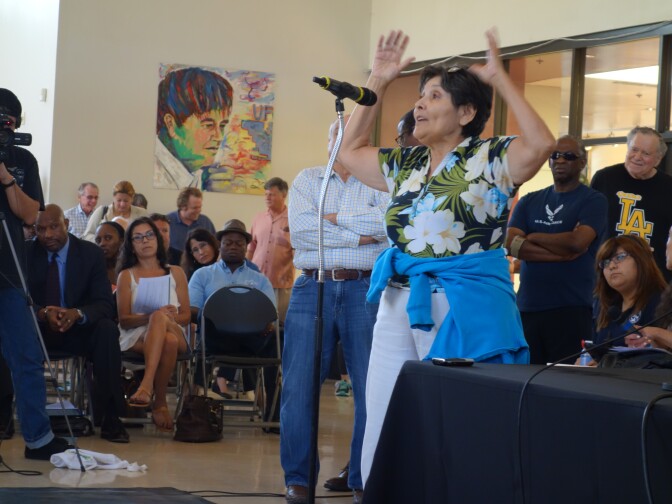With our free press under threat and federal funding for public media gone, your support matters more than ever. Help keep the LAist newsroom strong, become a monthly member or increase your support today.
Long Beach faults Southern California Edison power outage responses
Southern California Edison executives assured state lawmakers and Long Beach city officials on Saturday that it would respond to future power outages with greater competence and speed than it did during two protracted blackouts in July.
Two of the utility's top executives took harsh criticism at a town hall meeting for its slow response last July to electrical vault explosions and two sustained outages.
The power emergencies started July 15, when a cable splice went bad in an underground vault near 3rd Street and Chestnut Ave. in downtown Long Beach. The vault exploded, setting off a chain of other vault explosions and sending manholes airborne. As many as 22,000 customers lost power the first day of the outage, some of them elderly and disabled. The number fell to about 6,500 by the second day. It took five days for full service to be restored.
A second outage July 30 left more than 17,000 customers without power. That was reduced to 231 customers within a day, but some were offline for three days.
Saturday's town hall meeting was the first public venue at which Edison executives responded to questions from elected officials. (A utility official spoke at a Long Beach City Council meeting days after the first outage, but did not take questions.) Edison officials also offered repeated apologies for the flawed response and outages.
Southern California Edison is a huge utility -- it has 15 million business and residential customers in the region -- so the competence of its emergency response in a concentrated part of its service area resonates beyond city limits.
Assemblyman Anthony Rendon arranged the meeting Saturday at Cesar Chavez Park in the heart of the downtown area most affected by the repeated outages. He represents a portion of Long Beach and chairs the Assembly committee that oversees the California Public Utilities Commission.
Assembly members Patrick O'Donnell and Mike Gipson, state Sen. Ricardo Lara and Mayor Robert Garcia also sat on the town hall panel. They questioned representatives of Edison and local officials about the power outages and emergency responses. Signal Hill Mayor Larry Forester also attended.
What were the major criticisms?
City officials complained that Edison was missing in action during the early days of the outage. They say it took Edison too long to send a representative to the city's emergency operations center and police command post.
The Edison representatives who did show up, Deputy Fire Chief Rich Brandt said, lacked experience operating power systems. That became a problem because they couldn't explain the problems or fixes.
Brandt adds the lack of authoritative Edison personnel to assist police and fire departments meant crews were unable to say when new parts of the city power grid were being shut down or brought back up. He says that prevented emergency services from going to those areas to manage traffic and provide security.
Also, Brandt said Edison failed to send a spokesperson to the media staging area on the first night of the power outage, which resulted in city officials giving superficial information to the public.
"This lack of visible presence led to one-way messaging from our city to residents that was completely void of information from Edison," Brandt said.
City officials and Edison representatives agreed that the utility's response was far more competent for the July 30 power outage.
What did the state lawmakers want to know?
The two biggest issues were Edison's payments to residents who lost power, and questions about how diligently Edison was maintaining its power grid in the city.
Edison promised to pay each of its residential customers a $100 electrical bill credit for each incident to cover basic losses, and the inconvenience of not having power for days.
Those who lost more were invited to submit claims with Edison -- and the company was not requiring receipts, for the most part. It was also promising to make $100 payments to households that are not directly billed as Edison customers, including residents of one of the high rise senior apartment buildings.
"The hardship that people experienced is what catches my attention the most," Ferree said after the meeting.
Assemblyman Mike Gipson, who represents North Long Beach, questioned whether $100 was sufficient compensation for people who were without power for three to four days. He suggested Edison should have obtained hotel rooms for some of them.
The state lawmakers also wanted to know if Edison was meeting state deadlines to inspect underground power vaults once every three years.
The answers in the public meeting were not very precise, but Edison Vice President Greg Ferree said in an interview after the meeting that the company was meeting its deadlines.
"The short answer is yes, we were," he said.
The first vault to explode July 15 -- the one that set off a chain reaction of fires and blasts that sent manhole covers flying in the air -- was inspected on time, Ferree said.
"That vault was inspected and all of our normal maintenance and compliance and inspection activities were up to date," he said.
After another explosion and outage July 30, Edison inspected all 300 vaults in downtown Long Beach. That raised the question of whether the utility had met past deadlines for vault inspections.
Feree said Edison missed inspecting one of those vaults back in 2013. But it had been inspected twice since then, and was not one of those that failed in July.
What were some of the public comments?
Resident Gary Shelton addressed state lawmakers about the confusion his neighbors experienced during the blackout. He described some of their questions:
"How long will my power be down? Am I in danger from threat of more explosions? When will the generators arrive, if ever?" he said. "Must I sleep in my wheelchair another night in this stuffy lobby?"
Businesses also took a big hit from the outages. Thousands of visitors had filled downtown hotels for a dance event when the outage hit on July 15. Quentin Roberts, vice president for sales with the Long Beach Convention and Visitors' Bureau said the outages put a question mark on the city's reputation as a vacation and conference destination.
"People are wondering, 'Hey, do we come to Long Beach, or do we visit another city that has a more stable power grid?'" Roberts said.
What did the PUC have to say?
PUC Commissioner Catherine Sandovol said the agency, which regulates investor-owned utilities like Southern California Edison, called on Edison to respond to PUC investigator questions in public. Normally, PUC investigations are held behind closed doors, with its findings made public only after the inquiries are finished.
An Edison representative did not respond to the suggestion at the public meeting. Ferree said afterward that Saturday's town hall meeting represented that sort of public discussion. He said the results of an investigation commissioned by Edison but performed by a third party, Davies Consulting, would be made public.











